Prince Edward Island, or PEI, is a small province known for its rural landscapes and natural beauty. It even has its own endemic fungus, although it does not produce mushrooms[i]. But plenty of other fungi do make mushrooms on PEI, more different kinds than we can fit in one article. Here are a few of the more interesting species[ii].
This list of edible mushrooms should not be treated as guidance for new foragers—mushroom identification, while not intrinsically difficult, is much harder for people who are inexperienced. Mistakes are a lot easier. Beginners should therefore focus simply on identification, the same way birders enjoy naming the birds they see without expecting to eat them. Only when you have become proficient can you move on to foraging for the table.
The purpose of this list is solely educational and it is not meant to replace a field guide, spore prints, or an identification app. It is strongly advised to seek guidance from an expert in person if you plan to go mushroom hunting. Additionally, it is crucial to bring a high-quality knife and a basket or bag.
Here are some of the mushrooms you can look forward to finding.
Our Recommended Field Guides for Prince Edward Island
COVER | TITLE | Header | ||
|---|---|---|---|---|
OUR #1 RATED | ||||
Edible Mushrooms in PEI
Puffballs














Puffballs are a group of mostly-unrelated fungi that all develop their spores inside ball-shaped fruiting bodies. Many writers will say that all puffballs are edible, but that’s not true—because “puffball” isn’t a taxonomic group, any ball-shaped mushroom is a puffball, including the poisonous ones. It’s also important to slice puffballs vertically before cooking them to make sure the spores have no yet begun to develop and to make sure the interior is white and homogeneous; any indication of internal structure means it’s not a puffball and could well be poisonous. But it is true that many puffballs are good to eat.
PEI has at least nine edible puffball species in three genera. Most are in the Lycoperdon genus (which some authorities have re-named). Note that there is also a member of this genus in the Province that may be poisonous, so identification to species is important. Common Puffball (L. perlatum), Pear-Shaped Puffball (L. pyriforme), Meadow Puffball (L. pratense), Curtis’s Puffball (L. curtisii), and Pestle Puffball (L. excipuliforme) are all small, with short but thick stems. Most have short spines.
Three more are in the Calvatia genus. These are large to very large, and should be refrigerated after picking as they can go bad fast. Giant puffball (C. gigantea) is the aptly-named largest—it can reach basketball size and has no stem. It is just a ball. The Purple-Spored Puffball (C. cyathiformis) tops out at around soccer-ball size and may or may not have a short stem. The Yellow Puffball (C. flava) seems to be in the process of taxonomic revision, making it hard for us to find information about it. But it is large and yellow.
The Lead-Gray Puffball (Bovista plumbea) is small and stemless. At maturity, it detaches from the ground and rolls about in the wind, distributing spores—we could call it a tumble-puff. It is edible, but apparently not many people like it.
Boletes
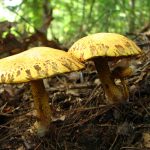









The boletes are related to each other, but they are divided up into many genera that seem to change every other week. Seriously, the taxonomy here is hard to keep up with. Boletes have the classic umbrella-like mushroom shape, but instead of gills they have a layer of pores. Some boletes are poisonous, but many are good to eat, and a few are choice. Here are just a few of PEI’s edible boletes: Chicken Fat Mushroom (Suillus americanus); Larch Bolette (Suillus grevillei); Old-Man-of-the-Woods (Strobilomyces strobilaceus), Bicolored Bolete (Baorangia bicolor); and Peppery Bolete (Chalciporus piperatus).
Chanterelles (Cantharellus sp.) and Trumpets (Craterellus sp.)


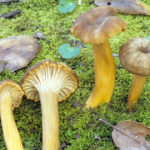





Chanterelles are a genus of mostly delicious mushrooms. Trumpets are closely related, and in fact many are also referred to as chanterelles. Both are part of a related group of mushrooms that are roughly trumpet-shaped and have ridges or veins rather than gills.
Curiously, we have only gotten confirmation of a single Cantharellus species on PEI, the recently-discovered Labrador Golden Chanterelle (Cantharellus enelensis). But there are least four trumpets to try: Yellowfoot (Craterellus tubaeformis), Flame Chanterelle (Craterellus ignicolor), and Horn-of-Plenty (Craterellus cornucopioides).
Oyster Mushrooms (Pleurotus sp.)






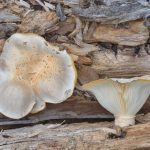

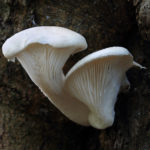

Oyster Mushrooms are a group of closely-related prized edibles. They do not taste like oysters, but many of them look a bit like oysters, being soft, roundish, and whitish or gray in color. Most are attached to their substrate (and the mycelium within) on the side and either lack a stem or have only a short, thick one like the handle of a fry-pan. The fruit from wood, and the species of the host tree is often a good indication as to which oyster you’ve got.
The original oyster mushroom, the one from which the others all got their name, is Pleurotus ostreatus, and PEI has it. Other local oysters include Summer Oyster (Pleurotus pulmonarius), Aspen Oyster (Pleurotus populinus), and Smooth Oyster (Pleurotus levis), which looks almost nothing like most other oysters, except for Veiled Oyster (Pleurotus dryinus), another PEI resident, from which it is almost indistinguishable[iii]. They’re all edible, though there are some oyster look-alikes that aren’t.
Edible Russulas




The Russulas, or brittlegills, are perhaps best known for the poisonous or unpalatable species among them, but quite a number are not only safe to eat but considered choice. These are pretty mushrooms, with often brightly-colored caps and white or whitish stems and gills. PEI has at least two species, the pale but lovely Yellow Swamp Brittlegill (Russula claroflava) and the Dark Red Shellfish-Scented Russula (Russula xerampelina)
Inkcaps






Inkcaps have a fun trick—they turn to ink at maturity and ooze away. Collecting them is tricky, for if handled or stored badly, they will turn to ink all the faster. Many, though not all, are good to eat.
Many mycologists say that inkcaps are obviously inedible once they start to turn, but that’s not true. Ink won’t work in recipes calling for mushrooms, granted, but inkcap ink has its own culinary uses. Many mycologists also say that several species are poisonous in that they’ll make you sick if you drink alcohol—it’s true that some inkcaps cause temporary alcohol intolerance (the effect lasts almost a week), but if you don’t drink alcohol until the mushroom is out of your system, you’ll be fine. Curiously, most inkcaps aren’t closely related to each other.
Shaggy Mane (Coprinus comatus) is quite good, and it’s fine to eat while drinking. Common Inkcap (Coprinopsis atramentaria) and Mica Cap (Coprinellus micaceus) are both good but mean no alcohol for a week.
Hericiums






Lion’s Mane (Hericium erinaceus) is the most famous of this little group. Its fruiting body takes the form of a short club covered all over with long, white or off-white, hair-like teeth or spines, rather like a pom-pom. Bear’s Head (Hericium Americanum) is similar except that its central club branches, and its spines are longer. Coral Tooth (Hericium coralloides) branches as well but has much shorter spines. All three are good to eat, with a mildly seafood-like flavor. The hairlike spines don’t have a noticeable texture in the mouth.
Lion’s mane is reputed to have some medicinal benefits, as suggested by preliminary research. Writers often treat all three species as medicinally interchangeable, but it’s worth noting there is, as yet, no evidence for that.
Edible Amanitas


The Amanita genus is famous for its poisonous members, some of which are deadly. But while many experts say, with good reason, not to eat any Amanita for fear of eating the wrong one, some are actually good to eat. PEI has at least one, the Tawny Grisette (Amanita fulva), a pretty little mushroom with a red-brown cap.
Our Recommended Field Guides for Prince Edward Island
COVER | TITLE | Header | ||
|---|---|---|---|---|
OUR #1 RATED | ||||
Poisonous Mushrooms in PEI
The following list is not exhaustive—don’t assume a mushroom is edible just because it’s not on here. It’s also worth noting that for a great many mushroom species, edibility is simply not known.
Most mushrooms are probably safe to eat, though not necessarily delicious. Relatively few mushrooms are known to be poisonous, and of those that are, most are only mildly so. It’s just that the exceptions are important to know about.
Poisonous Amanitas




Although some Amanitas are safe to eat and a great many are of unknown status, there are quite a few that are seriously poisonous and a few that will probably kill anyone who eats one.
The Eastern North American Destroying Angel (Amanita bisporigera) is one of this last group. The destroying angels are a subgroup of Amanitas that are all large, handsome, white or whitish mushrooms, all of them deadly if eaten. They all look very much alike, but in most cases geography is a great clue to identification—and it really doesn’t matter, because the important thing is to just know that it’s in the destroying angel group and admire it without eating it. Curiously, although destroying angels, as a group, are very distinctive-looking, they are not uncommonly mistaken for virtually every white, edible mushroom out there, from inkcaps to parasols to puffballs. Evidently, identification is harder than it seems, and care is always in order.
Fly Agaric (Amanita muscaria) has a different set of poisons than the destroying angels do, and it probably won’t kill you if you eat it. Indeed if it is properly processed, it can be used as a psychoactive mushroom, though it’s high is very different from that of the psilocybin mushrooms. However, if you make a mistake during processing, you could well end up hospitalized. At least it’s harder to mistake for any of the culinary mushrooms.
Deadly Galerina (Galerina marginata)
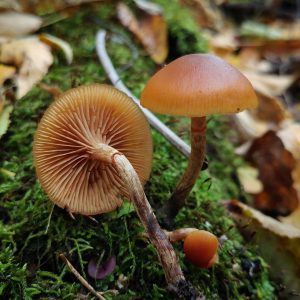

The aptly-named Deadly Galerina, also called the funeral bell, contains the same toxin as the Destroying Angels and in similar amounts. What makes this toxin so dangerous is that not only is it capable of killing—medical treatment raises your chance of survival but does not guarantee it—but because symptoms can take a very long time to show up, diagnosis it difficult. Then there’s the issue that the Deadly Galerina is a little, non-descript brownish mushroom and can easily be mistaken for any other non-descript little brownish mushrooms, of which there are many.
Poisonous Puffballs in PEI




There are a number of poisonous puffball species, and while they are unlikely to kill anybody, if you eat one, you’ll wish you hadn’t. Most of them are in the earthball group. Earthballs are difficult to differentiate from each other, but they differ from edible puffballs of the same size range in having thicker skin, much firmer flesh (think of a rubber ball rather than a marshmallow) and an interior that starts to darken very early in development. PEI has at least two, Common Earthball (Scleroderma citrinum) and Onion Earthball (Scleroderma cepa).
False Morels










False morels are mostly members of the genus, Gyromitra, a puzzling group that some people insist are fine to eat while others insist the opposite. The problem is that some people get sick from eating them, while others don’t. The primary toxin is destroyed by cooking, though the cooking has to be in a well-ventilated area as the fumes are also toxic. But there is another toxin that isn’t destroyed by cooking and is cumulative—you don’t show symptoms until after you’ve had many meals, and then you can suddenly get very sick. Most probably, the toxin load varies between species, so that properly-cooked mushrooms of some species are fine to eat, at least occasionally, while others should be left alone. But the debates continue to rage. Though they look a bit like morels, most people who eat them do so on purpose.
In any case, PEI has at least three Gyromitras: False Morel (Gyromitra esculenta), Bull Nose (Gyromitra gigas), and Pig’s Ears (Gyromitra ancilis). Two Helvella species are also present. These also look vaguely morel-like and are edible if cooked well, but when cooked well they lose their texture and taste. They might also be carcinogenic. Butter to look but not taste. PEI’s two are White Saddle (Helvella crispa) and Elfin Saddle (Helvella lacunosa).
False Parasol (Chlorophyllum molybdites)
False parasol is a bit of a misnomer in that there is nothing false about it; of the Shaggy Parasol group, mushrooms that are sometimes poisonous, sometimes not, this is simply the most poisonous—not lethal, just nasty. It’s also a close look-alike for quite a number of popular edible species.
Red Russulas (Russula Sp.)


As much as some Russulas make good eating, some very much don’t (and are very much poison) In most cases, the issue is simply one of unpalatability, but a few also cause some stomach illness. Many of these have red caps and are white otherwise—and Russulas that fit that description are more or less impossible to identify[iv]. They’re not identical, it’s just that the taxonomy is poorly defined and in need of an overhaul. Until that overhaul happens, it might be better to just not eat the red-and-white ones. There is a reason they are commonly referred to as The Sickener.
Our Recommended Field Guides for Prince Edward Island
COVER | TITLE | Header | ||
|---|---|---|---|---|
OUR #1 RATED | ||||
Magic Mushrooms in PEI
PEI only has a few psychoactive species[v]—many of these mushrooms are tropical or subtropical, and PEI is definitely neither. Anyone interested in sampling these species should exercise extreme caution. Not only is using psilocybin not without risk, but it’s also illegal. And all psilocybin mushrooms bear a disturbing resemblance to the aptly-named deadly galerina. People have died by making that mistake.
Rustgills (Gymnopilus sp.)


The Rustgills, often called gyms by psychonauts, are psychoactive, although there isn’t much published information on what their high is really like. Their primary active ingredient is psilocybin. The taxonomy of the group is currently confused, so it’s hard to be sure which species PEI has.
Banded Mottlegill (Panaeolus cinctulus)


Mottlegills, often called pans by psychonauts, are a mixed lot, including very potent species and totally inactive ones. The Banded Mottlegill is in the middle of the scale, with moderate to slightly low potency.
Liberty Cap (Psilocybe semilanceata)


Liberty Cap is a member of the same genus as the famous Psilocybe cubensis, but it is more potent and also more tolerant of cold climates. It is among the best-known and most popular psychoactive species out there.
References:
[i] (n.d.). Prince Edward Island. Wikipedia
[ii] (n.d.). Prince Edward Island. iNaturalist
[iii] Kuo, M. (2018). Pleurotus dryinus. MushroomExpert
[iv] Kuo, M. (2009). The Genus Russula. MushroomExpert
[v] (n.d.). Which Psilocybin Mushrooms Grow Wild in My Area? Shroomery
Our Recommended Field Guides for Prince Edward Island
COVER | TITLE | Header | ||
|---|---|---|---|---|
OUR #1 RATED | ||||






